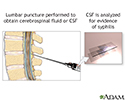CSF-VDRL test
Venereal disease research laboratory slide test - CSF; Neurosyphilis - VDRL
The CSF-VDRL test is used to help diagnose neurosyphilis. It looks for substances (proteins) called antibodies, which are sometimes produced by the body in reaction to the syphilis-causing bacteria.
How the Test is Performed
A sample of spinal fluid is needed.
How to Prepare for the Test
Follow the health care provider's instructions on how to prepare for this test.
Why the Test is Performed
The CSF-VDRL test is done to diagnose syphilis in the brain or spinal cord. Brain and spinal cord involvement is often a sign of late-stage syphilis.
Blood screening tests (VDRL and RPR) are better at detecting middle-stage (secondary) syphilis.
Normal Results
A negative result is normal.
False-negatives can occur. This means you can have syphilis even if this test is normal. Therefore, a negative test does not always rule out the infection. Other signs and tests may be used to diagnose neurosyphilis.
What Abnormal Results Mean
A positive result is abnormal and is a sign of neurosyphilis.
Risks
Risks for this test are those related to lumbar puncture, which may include:
- Bleeding into the spinal canal or around the brain (subdural hematomas).
- Discomfort during the test.
- Headache after the test that can last a few hours or days. If headaches last more than a few days (especially when you sit, stand or walk) you might have a CSF-leak. You should talk to your physician if this occurs.
- Hypersensitivity (allergic) reaction to the anesthetic.
- Infection introduced by the needle going through the skin.
Your provider can tell you about any other risks.
References
Karcher DS, McPherson RA. Cerebrospinal, synovial, serous body fluids, and alternative specimens. In: McPherson RA, Pincus MR, eds. Henry's Clinical Diagnosis and Management by Laboratory Methods. 24th ed. Philadelphia, PA: Elsevier; 2022:chap 30.
Radolf JD, Tramont EC, Salazar JC. Syphilis (Treponema pallidum). In: Bennett JE, Dolin R, Blaser MJ, eds. Mandell, Douglas, and Bennett's Principles and Practice of Infectious Diseases. 9th ed. Philadelphia, PA: Elsevier; 2020:chap 237.
Review Date: 9/1/2021
Reviewed By: Jatin M. Vyas, MD, PhD, Associate Professor in Medicine, Harvard Medical School; Associate in Medicine, Division of Infectious Disease, Department of Medicine, Massachusetts General Hospital, Boston, MA. Also reviewed by David Zieve, MD, MHA, Medical Director, Brenda Conaway, Editorial Director, and the A.D.A.M. Editorial team.






